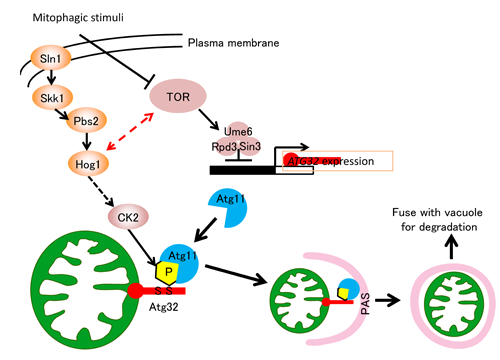Cellular Physiology
HOME > Activities > Basic Medicine > Cellular Physiology
1.Summary
Mitochondrial oxidative phosphorylation produces a large amount of energy, which contributes to a range of cellular activities. Maintaining the quality and quantity of mitochondria is important, and accordingly, the cell has evolved specific mechanisms to ensure quality and quantity control systems. Mitochondria autophagy, or mitophagy, is one of the mitochondrial quality control systems, which can selectively eliminate damaged or excess mitochondria. We are investigating the molecular mechanism and physiological role of mitophagy.
2.Research Result
A genome-wide screen for mutants that are defective in mitophagy identified ATG32 as an indispensable gene for mitophagy (Kanki T. et al. Mol Biol Cell. 2009, Kanki T. et al. Dev Cell. 2009). Atg32, the protein encoded by ATG32, is a mitochondrial outer membrane protein. When mitophagy is induced, serine 114 and serine 119 on Atg32 are phosphorylated by casein kinase 2 (CK2) (Aoki Y. et al. Mol Biol Cell. 2011, Kanki T. et al. EMBO Rep. 2013). Then, Atg11, the cytosolic adaptor protein for selective autophagy, interacts with phosphorylated Atg32, especially at phosphorylated serine 114. Finally, Atg11 recruits mitochondria to the phagophore assembly site/pre-autophagosomal structure. Subsequently, the isolation membrane is generated, and mitochondria are selectively sequestered by autophagosomes for degradation.

Please see the Cellular Physiology website for a detailed description of our research.
